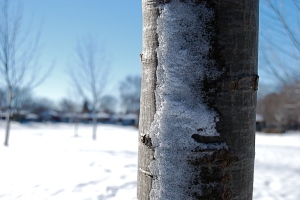Cold weather helps to spread flu across the country
 A very cool new study from McMaster University researchers shows how weather patterns impact the spread of influenza A virus across Canada. Using outbreak data gathered over more than 13 years, the virus could be tracked over time and space. Influenza A tended to first emerge in the colder, less humid provinces of Western Canada (British Columbia and Alberta), and then spread across the country to the East. Schools also represented hotbeds of infection – when they were shut during the Summer, there were significantly fewer cases of flu recorded.
A very cool new study from McMaster University researchers shows how weather patterns impact the spread of influenza A virus across Canada. Using outbreak data gathered over more than 13 years, the virus could be tracked over time and space. Influenza A tended to first emerge in the colder, less humid provinces of Western Canada (British Columbia and Alberta), and then spread across the country to the East. Schools also represented hotbeds of infection – when they were shut during the Summer, there were significantly fewer cases of flu recorded.
Investigating the ‘ouch’ factor during a bacterial infection
 When a bacterial infection takes hold, it’s usually a painful experience. During a normal immune response, immune cells infiltrate the infected area, pummel the invading bacteria and in doing so release molecules that cause swelling and pain. Yet new research from Harvard Medical School shows that it’s not only the immune system that is to blame: at least some of the pain comes from the bacteria themselves secreting factors that can interact directly with our nervous system.
When a bacterial infection takes hold, it’s usually a painful experience. During a normal immune response, immune cells infiltrate the infected area, pummel the invading bacteria and in doing so release molecules that cause swelling and pain. Yet new research from Harvard Medical School shows that it’s not only the immune system that is to blame: at least some of the pain comes from the bacteria themselves secreting factors that can interact directly with our nervous system.
The immune system’s need for speed
 Our beautiful human bodies have several portals where nasty pathogens, such as bacteria, can enter and wreak havoc. Once inside the human body, bacteria start reproducing straight away, doubling their numbers around once every 20 minutes. Yet our immune T cells constantly patrol such vulnerable open-access areas, sampling their environment to identify threatening material. A reassuring new study has now come out showing that reactive T cells sense such foreign material within a few seconds, and make the decision to respond to malevolent threats within a speedy minute.
Our beautiful human bodies have several portals where nasty pathogens, such as bacteria, can enter and wreak havoc. Once inside the human body, bacteria start reproducing straight away, doubling their numbers around once every 20 minutes. Yet our immune T cells constantly patrol such vulnerable open-access areas, sampling their environment to identify threatening material. A reassuring new study has now come out showing that reactive T cells sense such foreign material within a few seconds, and make the decision to respond to malevolent threats within a speedy minute.
Edible vaccines, om nom nom!
 Rotavirus infection is one of the major nasty causes of childhood diahorrea, but can happily be prevented with an oral vaccine. Vaccinated children in industrialised countries develop 85-98% immune protection, while those in the third world develop a much lower protection level of 50-60%. The reasons behind this startling difference are not well characterised, but third world kiddies would obviously benefit from a boost in their rotavirus immune protection.
Rotavirus infection is one of the major nasty causes of childhood diahorrea, but can happily be prevented with an oral vaccine. Vaccinated children in industrialised countries develop 85-98% immune protection, while those in the third world develop a much lower protection level of 50-60%. The reasons behind this startling difference are not well characterised, but third world kiddies would obviously benefit from a boost in their rotavirus immune protection.
One team has come up with a new way of administering such an immune upgrade – by loading rice, a staple food in the third world, with anti-rotavirus immune-boosting antibodies. This tasty dish could conceivably be consumed regularly during childhood to maintain protection levels.
Originally posted on Scizzle.




